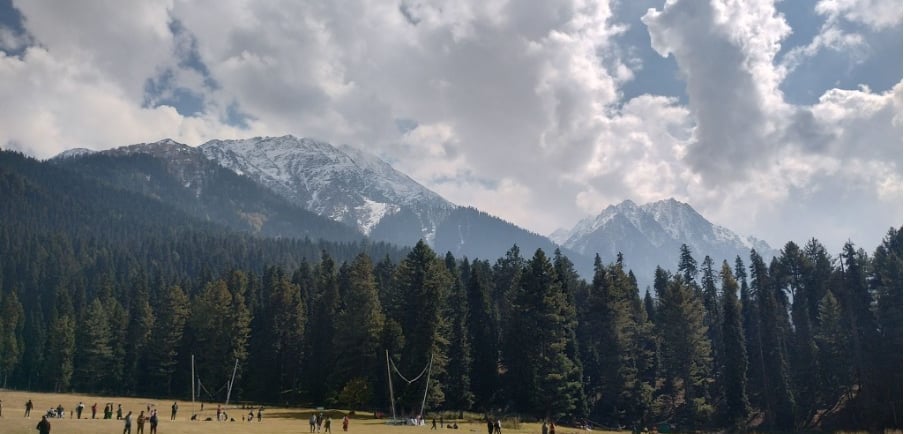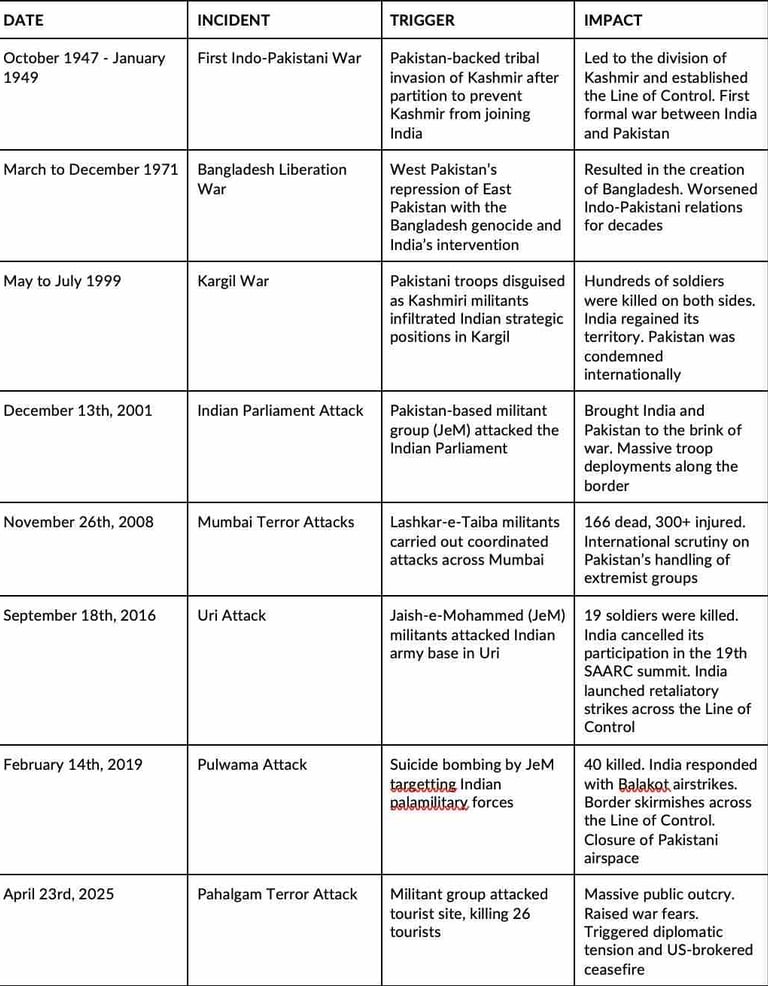Pahaglam Terror Attack - South Asia's Cycle of Conflict
If India and Pakistan continue to view each other as existential threats, South Asia will never break free from its cycle of conflict and the Pahalgam terror attack would simply be another entry into the region’s long list of tragedies, rather than a turning point for regional stability and long term peace.
COMMENTARIES
Neathan Fernando
6/15/20254 min read


Only the sound of sirens and screams remained in the Valley of Shepherds as 26 innocent tourists were shot dead in a brutal terrorist attack that would bring South Asia back to the brink of war. The attack was not an isolated incident but a symptom of the regional instability that has plagued South Asia for decades, a symptom of the endless cycle of militarism and nationalism between the two major powers of South Asia. Until South Asia can move forward into proactively fighting for regional stability through stronger frameworks, regional cooperation, and economic interdependence, South Asia is doomed to continue its cycle of conflict.
WHY DOES REGIONAL STABILITY MATTER?
Regional stability is not optional, it is the foundation of a country’s future and its future generations. For countries such as Sri Lanka, peace between India and Pakistan is a matter of national security. With Sri Lanka’s reliance on trade passing through the Bay of Bengal and the Arabian Sea, any naval confrontation between the regional powers would disrupt shipping and collapse smaller economies like Sri Lanka’s. Tensions between the two regional powers prevents frameworks such as SAARC from reaching their potential and fosters a breeding ground for greater extremist movements.
Former Pakistani Prime Minister Imran Khan also stated at the World Economic Forum in 2023 that the “World will realise Pakistan’s strategic potential once relations with India normalise”, highlighting how regional stability would benefit not only the rest of South Asia, but India and Pakistan too.
To understand why regional stability is essential and how the cycle of conflict sustained by the two major powers of South Asia hinders the possibility of long term regional stability, the table below highlights the key incidents that disrupted peace in South Asia, along with what triggered the incident, as well as the consequences that followed.
History has shown that instability does not remain confined to a single territory; refugees flee across borders, investors pull out of the region in fear, tourism drops due to potential danger, countries become more nationalist and militarist, and extremism continues to spread. Prolonged conflict over the Pahalgam terror attack would have limited the subcontinent’s chance for a better future, prolonging prosperity for South Asia for decades to come and trapping the region in its endless cycle of conflict.
THE COST OF CONFLICT: ECONOMICALLY AND POLITICALLY
The war fever in Pakistan temporarily boosted morale and the domestic perception of the military, but the economic cost of a prolonged conflict would be unimaginable. Pakistan is crippled by past inflation, energy shortages, and unsustainable levels of debt. A full-scale conflict would only worsen these crises. Even India, significantly economically stronger, would have struggled, with conflicts damaging investor confidence, slowing down tourism, and diverting public funds to military spending.
While both nations race to counter each other, they often neglect the core issues that fuel extremism such as poverty, unemployment, and ethnic tensions, creating an environment for extremists to easily gain support among a struggling population.
Looking to the rest of the region, Sri Lanka’s 30 year civil war had cost more than 100,000 lives and billions in lost economic development. Yet while the civil war ended through military victory, it did not resolve the political and ethnic divisions that started the conflict. Peace demanded inclusive governance, cooperation, and a commitment to human dignity. The India-Pakistan dynamic has yet to reach that shift in perspective and without this shift, the region will forever remain a prisoner of the past, fighting over territory that has been disputed for a lifetime.
WHY TERRORISM PERSISTS IN SOUTH ASIA
Terrorism did not begin in Pahalgam and it will not end there either. From the Taliban’s resurgence in Afghanistan to Sri Lanka’s Easter Bombings, the region remains vulnerable to extremist attacks. Like Indian Prime Minister Modi stated in the G20 Summit of 2023, “Terrorism, wherever it may be, for whatever reason, in whatever form, is against humanity” and South Asia must prevail in its fight against terrorism.
Militant groups in Pakistan exploit lawless border regions, while established insurgencies in Kashmir and India’s northeast show that repression will never stamp out rebellion. Across South Asia, governments often respond to terrorism with militarism and blame, rather than counterterrorism strategies or deradicalization.
THE ROLE OF NATIONALISM AND RELIGIOUS EXTREMISM
Nationalism and religious extremism are powerful forces in both India and Pakistan, with Hindu nationalism growing in political dominance in India over the last few decades, while Islamic identity is used to unify the fragmented population of Pakistan. Both governments use these identities to rally support and suppress dissent.
Pakistan’s military popularity did not spike through reform, but instead through a narrative of symbolic victory over India. This is not uniquely a Pakistani situation, with most of South Asia having experienced leaders who stoke external fears in order to distract from domestic crises. This is a dangerous trend that normalizes conflict for populations and polarizes entire societies. This polarization fuels support for more extremist movements across the region.
SRI LANKA CALLS FOR LONG TERM PEACE
South Asia stands at a crossroad. While the US-brokered ceasefire between India and Pakistan is welcome, South Asia needs a resolution that would foster long-term stability with frameworks that support dialogue over war and create economic interdependence, in order to prevent future conflicts and to prevent extremists movements from rising up around the region. Mediation must lead to long-term agreements, not just temporary ceasefires. The lives and futures of a quarter of the world’s population depend on it. If India and Pakistan continue to view each other as existential threats, South Asia will never break free from its cycle of conflict and the Pahalgam terror attack would simply be another entry into the region’s long list of tragedies, rather than a turning point for regional stability and long term peace.
*Neathan Fernando is a Research Assistant(Intern) from Sri Lanka at the South Asia Foresight Network(SAFN) in Washington,D.C.




